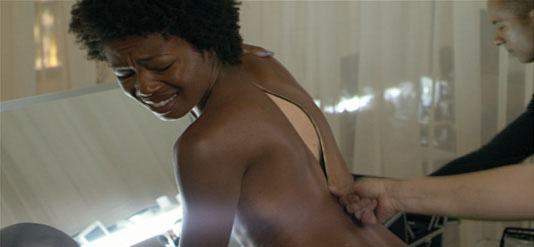“Xelibri: “Beauty for Sale”” by Fincher
Conference:
- SIGGRAPH 2004 More animation videos from SIGGRAPH 2004:


Title:
- Xelibri: “Beauty for Sale”
Length:
- 1:00
Director(s):
Company / Institution / Agency:
- Digital Domain, Inc.
Description:
Beauty isn’t what you think. That’s the theme behind David Fincher’s“Beauty For Sale.” Supermodels are actually fat people underneath.To create this gag, Digital Domain created CG fat bags and pulled off the illusion of fat people underneath the skin of various runway models during a fashion shoot. This was done by compositing several passes using different actors who made up the same person.Digital Domain was able to seamlessly blend the elements to pull off the sensation that a model would actually be a fat person wearing a suit. In one instance, a model walks across the room. The upper body is a man. The lower is a model woman with long legs. The two were integrated with motion-control passes using two different actors. We matched up the movement of the two and composited the upper body of the one to the lower body of the other. In other scenes, Digital Domain created CG skin to create the illusion that the model’s skin was being unzipped. As this is happening, computer-generated “fat” oozes out of her body suit.
Hardware:
HARDWARE: 2 GHz CPU, 2 GB RAM. Rendering farm: 500 CPUs.
Software:
SOFTWARE DEVELOPER: Modeling: Lightwave 7.5, Maya 5.1, Syslice 2.01. Animation:
Lightwave 7.5, Maya 5.1. Rendering: Lightwave 7.5. Dynamics: Maya
5.1, Syflex 2.01 Compositing: Nuke 4.0. Additional software: Track
Photoshop HDR Shop Custom software: DD proprietary tracking
software, DD Maya-to-Lightwave pipeline plug-ins. OS: Windows
2000.
Additional Contributors:
Executive Producer: Ed Ulbrich
Visual Effects Supervisor: Eric Barba
Visual Effects Producer: Michael Pardee
CG Supervisor: Karl Denham
Flame Artist: Patrick Ferguson
Additional Information:
PRODUCTION
Modeling: ultimately subdivision surfaces, human models scanned onset and cleaned up with Cyslice. Lightwave’s modeler used to create the camera orbs and other hard surface models and for additional cleanup and alteration on a few shots. Rotoscoping: The animations of the various body parts were all roto-mated over the live-action plates in Maya or Lightwave. Rendering technique used most:Mostly Lightwave with DD’s proprietary Light Wench plug-in to create accurate lighting models for each set. HDR domes were shot on setto drive the lighting rigs and for reflections. For all of the runway shots with camera orbs in them, a virtual HDR set was created to ensure accurate reflection positions that are not possible with adobe. Average CPU time for rendering per frame: varied greatly per object and scene. Shots were rendered as separate elements for additional compositing control. Total production time: 12 weeks (for visual effects).




